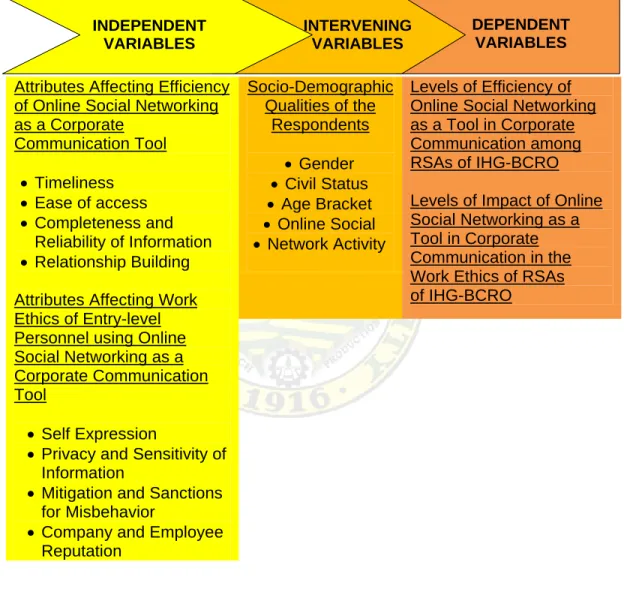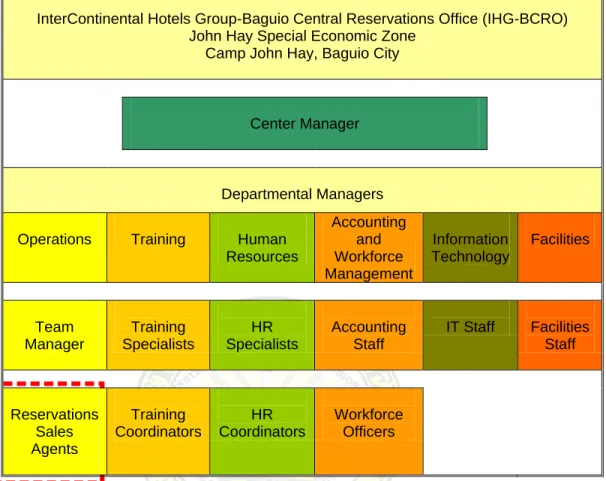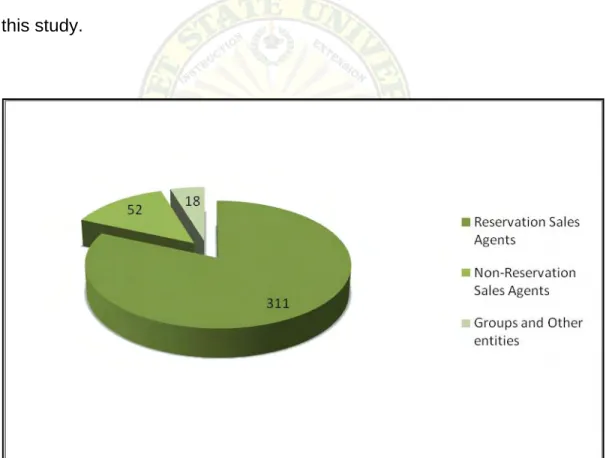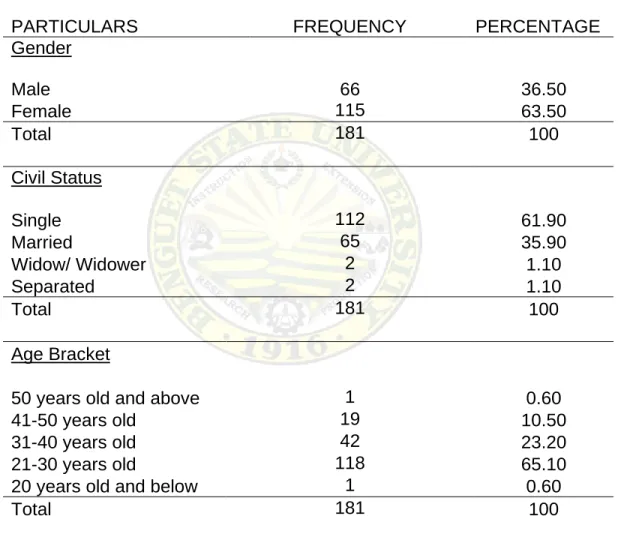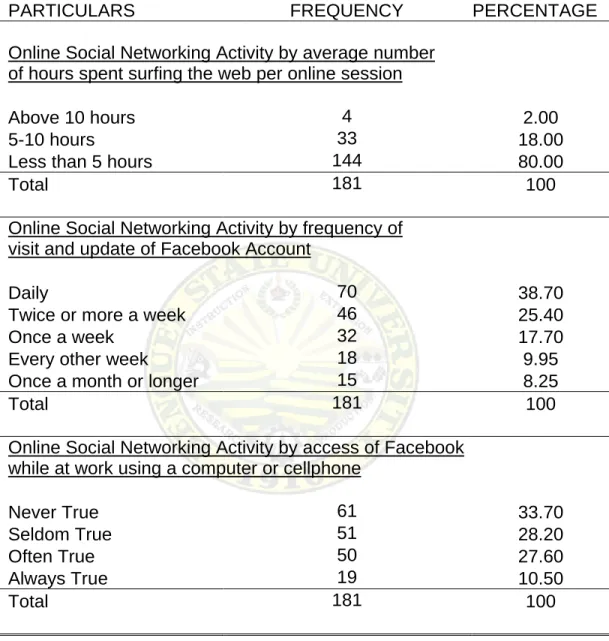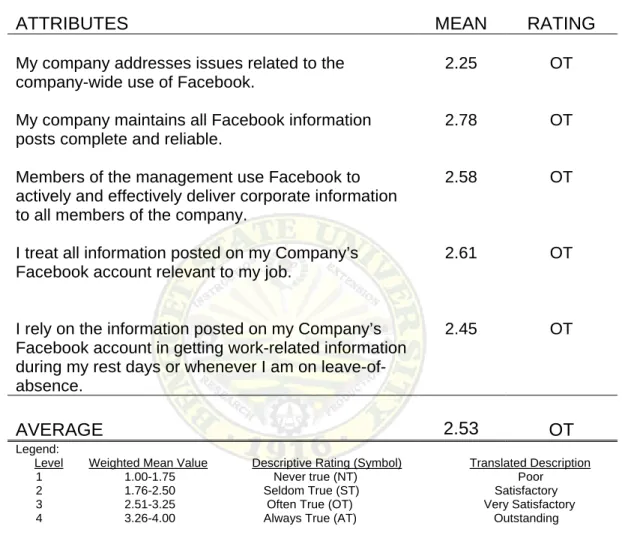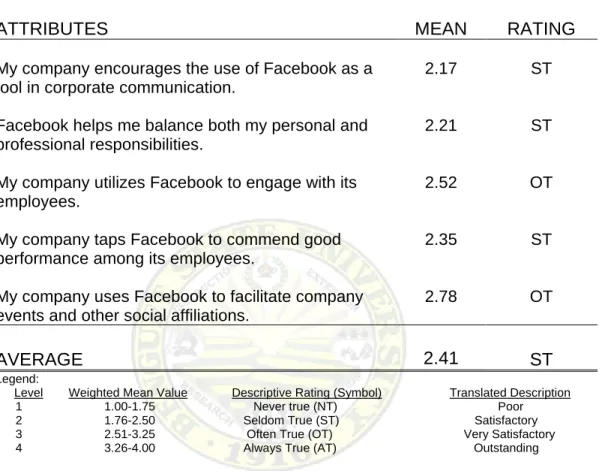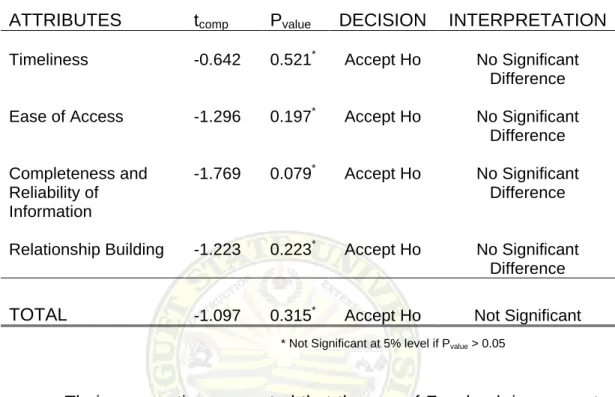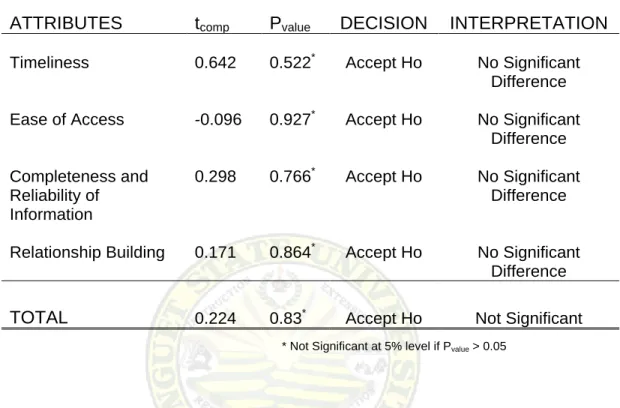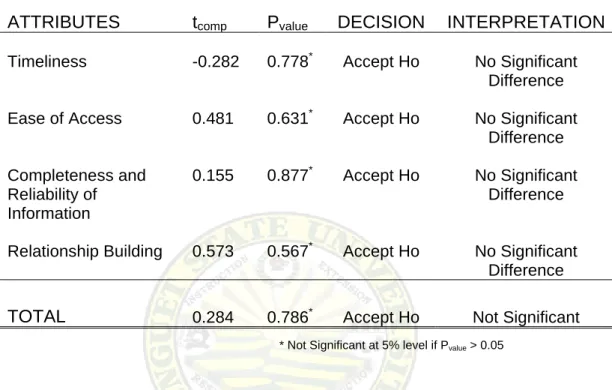BIBLIOGRAPHY
RUEL FRONDA RAMIREZ. May 2010. Online Social Networking and Ethics in Corporate Communication. Benguet State University, Open University, La Trinidad Benguet, Philippines.
Adviser: CORNELIA M. RILLERA, MPA
ABSTRACT
The study made an evaluation on the levels of efficiency of Facebook, an Online Social Networking site, as a tool in Corporate Communication and its impact on the Work Ethics of the Reservation Sales Agents (RSA), entry-level employees of InterContinental Hotels Group-Baguio Central Reservations Office (IHG-BCRO).
There were 181 RSAs who participated in the study. These RSAs are active Facebook users and are classified as Friends with the IHG-BCRO Facebook account (www.facebook.com/ihgbaguio). The respondents were chosen using Consecutive Sampling Technique.
The findings revealed very satisfactory efficiency levels of Facebook as a tool in corporate communication when assessed according to the attributes Timeliness, Ease of Access, Completeness and Reliability of Information and satisfactory in terms of Relationship Building.
The results show no significant difference in the RSAs views on the efficiency levels of Facebook as a tool in corporate communication when the respondents were
Activity by average number of hours spent surfing the internet per online session. The RSAs differ in opinion when they were grouped according to Online Social Networking Activity by frequency of Facebook account visit and update, and by access of Facebook account while at work.
The use of Facebook in corporate communication affecting the attributes Self Expression, Privacy and Sensitivity of Information and Mitigation and Sanctions for Misbehavior reveals low impact and the attribute Company and Employee Reputation shows average impact to the RSAs’ online social networking behavior and work ethics.
The impact levels of Facebook as a corporate communication tool show no significant difference however the RSAs were grouped demographically.
Facebook commits to its function as a corporate communication tool and has successfully and effectively reached its target audience: the employees of IHG-BCRO.
The results imply that the RSAs’ behavior in using Facebook was not governed by any solid or written guideline but relatively manifested by one’s judgment over the ethical use of Facebook as tool in corporate communication.
Companies need to realign the nature of business and mission-vision towards the online nature of Facebook in order to fully harness its potential as a tool in corporate communication. With this, employers and employees alike will become fully aware of the impacts in the use of Facebook to both their work productivity and work ethics hand- in-hand with the development of appropriate guidelines governing online social networking as a tool in corporate communication.
1 INTRODUCTION
Background of the Study
There have been a lot of discussions and studies regarding the processes involved in Corporate Communication. It is also expected that organizations set and follow unique guidelines and protocols to fluidly deliver the functions of communication with their colleagues. These guidelines and protocols are reflective of a company’s core values and are aligned towards the attainment of its mission-vision.
Over the years, communication tools, products and services are evolving from one form to another, bridging the communication process in faster, efficient and more interactive ways. Technological advancement and innovations are tailored to aid human needs and to make life’s processes easier, consequently, technology is constantly changing the way people do daily tasks and communicate.
Mobility is a key factor in the development of most communication tools. The electronic mail replaced the printed snail mail, conference call is now easier through instant messaging, the telephone has evolved into a mobile cellular phone, and the introduction of internet in the workplace outdated the local intranet. Needless to say, these examples aim to deliver an environment where one can be productive anywhere. As a result, the
2 physical workplace is now larger in magnitude and is more than our traditional perception of an office - a space where employees collectively report to and do work. The workplace has progressed to what is now conceptually known as the virtual workplace.
The idea of the virtual workplace practically sets aside the physical presence of an employee to be less-relevant towards his actual work performance and output. The impression of working at one’s own pace in his most convenient location is the main highlight of the virtual workplace.
Organizations that adopt methods of the virtual workplace are also devoted in utilizing sophisticated and top-of-the-line communication tools to support and satisfy the employees’ needs and sequentially to satisfactorily perform. Nowadays, most companies provide employees with corporate email addresses, company-issued mobile devices like cellular phones and laptop computers, among other gadgets or services that aid corporate communications. Likewise, these communication tools facilitate an easier way to monitor employees’ performance and output.
For practical reasons, however, it is most likely that an employee harnesses shared communication tools in performing both his professional and personal activities and responsibilities. Logically, It is more convenient to carry along one cellular phone that one may use to communicate with both co-workers and family members, it is easier to use one e-mail
3 account to share electronic mails to both workmates and friends, or in the case of this study, it is more sensible to maintain one Facebook account that enlists an individual’s boss, workmates, family members and friends altogether as Friends. This area may blur out the thin line that separates the professional and personal roles of an employee, thus, affecting focus and balance between an employees’ responsibilities and priorities.
The advent of internet is pivotal in the development of the virtual workplace. One quality that exemplifies the use of internet in the workplace is its being an open source: allowing anyone who has the access to be well supported with the information that one may need to stay connected virtually with anyone and anywhere in the world. The internet as a communication tool has become an essential part of almost everyone’s business. Nowadays, in order to become competitive in the marketing and branding arena, one should maintain a reputable online presence through websites.
With its solid role as a corporate communication tool, the internet evolved into a vital company resource. Eventually, the use of internet in the workplace as a communication tool has become fundamentally integrated with the company’s regulations on the proper use of company resources.
4 The increase in number of institutions that utilize Online Social Networking as a business tool is evident in the recent years. Effective marketing strategy is one of the main agenda of these companies in harnessing this form of social media.
Company guidelines against the improper use of resources made the use of internet in the workplace manageable. Technically however, these protocols are limited to the literal use of internet in conjunction with the productivity of an employee. However, behavior involving the use of internet vis-a-vis Online Social Networking per se as a tool in corporate communication is scarcely stipulated in the guidelines on work ethics (Haans-Mulder and Dekker, 2010).
This study encompasses four qualities of the Internet as an open source communication tool as specifically adapted towards Online Social Networking as a tool in corporate communication through: Timeliness, Ease of Access, Completeness and Reliability of Information, and Relationship Building. These areas are cross-examined on their impact on the possible vulnerability towards work ethics through: Self Expression, Privacy and Sensitivity of Information, Mitigation and Sanctions for Misbehavior, and Company and Employee Reputation.
Equally important, this study identifies the Entry-level employees as the target respondents. Entry-level personnel are the company’s driving
5 force in terms of productions and operations. In almost all companies, majority of its employees hold rank and file positions. Proper information dissemination among these employees is as important as the business process itself since this employee level is considered the lifeblood of the company operations (Cascio, 1998).
InterContinental Hotels Group (IHG) is an international hotel company and the world’s largest hotel chain in total number of guest rooms – 645, 000 rooms in over 4,400 hotels across nearly 100 countries.
IHG makes more than 146 million guests stays every year. The company operates the following hotel brands: InterContinental, Crowne Plaza, Hotel Indigo, Holiday Inn, Holiday Inn Express, Staybridge Suites and Candlewood Suites. IHG’s operating system also includes advertising and marketing campaigns, 11 global call centers, 13 local language websites and Priority Club Rewards – its hotel loyalty scheme with 56 million members.
IHG as a global company has many divisions. Distribution and Marketing operates Worldwide Reservations and Guest Relations.
Worldwide Reservations is globally responsible for all Central Reservations Offices (CROs), where customers call for reservations.
IHG’s worldwide reservation system operates 11 CROs that take hotel bookings from guests 24 hours a day in 15 languages. Guests are
6 assisted by Reservation Sales Agents (RSAs). Across the 11 IHG-CROs, majority of the workforce is under the entry-level position RSA. IHG estimated in 2011 a global sales force including RSAs of more than 9,000 professionals. RSAs handle 30,000-110,000 calls per day. It is expected that each RSA consistently deliver individual customer experience to all guests and become Great hotels guests love.
There are two IHG-Central Reservations Offices in the Philippines, one based in Makati City and one in Baguio City. The IHG-Central Reservations Office in Baguio City is located at the John Hay Special Economic Zone, Camp John Hay, Loakan Road. It started its operations in 2007 and presently employs more than 300 Reservation Sales Agents.
The IHG-Baguio Central Reservations Office (IHG-BCRO) utilizes a mixture of traditional and non-traditional corporate communication tools.
The company harnesses both computer-based and traditional media in executing the company’s internal corporate communication activities.
On September 2009, IHG-BCRO launched its Facebook account.
Alongside with other traditional forms, the IHG-BCRO Facebook account is designed to aid internal corporate communication. It focuses on inter- departmental advisories and various announcements, company events and projects, departmental job openings, congratulatory messages for promotions, employee birthday celebrators and achievers, among other
7 information posted in the Facebook account profile. Unlike other companies or groups that use a Facebook Group account settings, the IHG-BCRO Facebook account (IHG PHPRO) utilizes the generic Individual account setting. The account includes the following user tabs:
INFO-lists information about the company like contact information, etc.
WALL-where brief announcements, status messages and other information are placed, PHOTOS and VIDEOS–albums and compilation of photographs and videos related with the Wall announcements, LINKS–are website shortcuts for further information about an announcement, FRIENDS–enlists individuals, groups or entities who have added the account as a Friend, and NOTES –are longer and more detailed versions of the Wall announcements.
As of February 2011, the IHG-BCRO Facebook account enlists 381 Friends, including current employees, committee, group and team accounts, among other individuals and entities that are in one way or another connected with IHG-BCRO. Since IHG-BCRO uses Facebook’s individual interface, its Friends can interact with the account through mail and chat. Facebook interactive tools like Post a Comment, Like, Share and Tag are also limited to those who add the Facebook Account as a Friend. Upon adding the account as a Friend, one may be able to share
8 and Tag Posts, Photos and Videos and Links to the account and vice versa coined in Facebook as Wall to Wall Sharing.
Statement of the Problem
The main purpose of this study is to analyze the effects of Online Social Networking (specifically Facebook) in Corporate Communication and its impact on the Work Ethics of the Reservation Sales Agents, entry- level employees of InterContinental Hotels Group-Baguio Central Reservations Office.
The researcher sought answers to the following questions:
1. What are the levels of efficiency of Online Social Networking as a tool in Corporate Communication as perceived by the entry-level employees with respect to the following aspects:
a. Timeliness b. Ease of Access
c. Completeness and Reliability of Information d. Relationship Building?
2. What is the difference in the levels of efficiency of Online Social Networking as a tool in Corporate Communication when the respondents are grouped demographically as follows:
9 a. Gender
b. Civil Status c. Age Bracket
d. Online Social Network Activity?
3. What are the levels of impact of Online Social Networking as a tool in Corporate Communication in the respondents’ Work Ethics with respect to the following aspects:
a. Self Expression
b. Privacy and Sensitivity of Information c. Mitigation and Sanctions for Misbehavior d. Company and Employee Reputation?
4. What is the difference in the levels of impact of Online Social Networking as a tool in Corporate Communication in the respondents’ Work Ethics based on:
a. Gender b. Civil Status c. Age Bracket
d. Online Social Network Activity?
10 Objectives of the Study
This study has the following objectives:
1. To determine the levels of efficiency of Online Social Networking as a tool in Corporate Communication as perceived by the entry-level employees with respect to the following aspects:
a. Timeliness b. Ease of Access
c. Completeness and Reliability of Information d. Relationship Building
2. To determine if there is a significant difference in the levels of efficiency of Online Social Networking as a tool in Corporate Communication when the respondents are grouped demographically as follows:
a. Gender b. Civil Status c. Age Bracket
d. Online Social Network Activity
3. To determine the levels of impact of Online Social Networking as a tool in Corporate Communication in the respondents’ Work Ethics with respect to the following aspects:
11 a. Self Expression
b. Privacy and Sensitivity of Information c. Mitigation and Sanctions for Misbehavior d. Company and Employee Reputation
4. To determine if there is a significant difference in the levels of impact of Online Social Networking as a tool in Corporate Communication in the respondents’ Work Ethics based on:
a. Gender b. Civil Status c. Age Bracket
d. Online Social Network Activity
Importance of the Study
Social media as a communication tool revolutionized an active online presence not only among individuals, but also among groups and organizations. Social media earned a reputable standing in terms of number of users due to its user-centric interface. With this in mind, this study focuses on the end-users of the online social media to fully understand the impact of their online social networking behavior aligned with their personal and professional roles. Similarly, it is also expected that this study will bring awareness to groups and organizations towards the
12 significance of these end-user’s behavior in order to fully harness the advantages of social networking as a tool in corporate communication.
Technological advancement and its mediation in the workplace have had its fair share of deliberations regarding advantages and disadvantages, but above these, the main purpose of embracing the technology on the job goes hand-in-hand with making one’s work efficient.
Human Resource Management practitioners may tie together the result of this study in maintaining, modifying or adding the technologies in corporate communication, specifically the use of online social networking, that are appropriate to their respective organizations.
Most of the existing employee codes of ethics todate do not signify any position regarding the use of social online networking as a tool in corporate communication. Emphasis on the impact of self expression, privacy and sensitivity of information, mitigation and sanctions for misbehavior, and company and employee reputation are specified in this study to realign existing corporate guidelines at an imperative view to promote a more harmonious working environment.
At a more global perspective, this study is important at delivering a solid and substantial management style geared congruently with technology, human behavior and the proper guidelines that convey harmony between these two ever changing factors, thus Social Online
13 Networking focusing on Facebook as a tool in corporate communication (the technology) and its impact on work ethics among entry-level employees (the human behavior).
Scope and Delimitation of the Study
This study is limited on Facebook, an Online Social Networking site, as a tool in internal Corporate Communication and is focused on the entry-level personnel of the InterContinental Hotels Group-Baguio Central Reservations Office (IHG-BCRO), John Hay Special Economic Zone, Camp John Hay, Loakan Road, Baguio City, Philippines.
The respondents of this study are the entry-level personnel of the Operations Department of IHG-BCRO who are listed as Friends of the official Facebook account referred as IHG-PHPRO (www.facebook.com/ihgbaguio).
The total population presented in this study is the 311 RSAs that compose 81.60 percent of the total number of IHG-PHPRO’s 381 Facebook Friends as listed on February 2011.
This study focused on the internet-based browsing convention supported by web browsing gadgets like the computer, cellular phone and other web-browsing capable tools that directly access the Facebook website interface.
14 All information about IHG (the company) contained in this study are retrieved using the official company website www.ihgplc.com. The use of these information are limited to academic purposes. The researcher waives any misrepresentations that this paper may contain.
15 REVIEW OF LITERATURE
Importance of Effective Communication
Communication is the lifeblood of any organization. Communicating ideas and information makes action and coordination possible. Likewise, communication plays a major role in modifying behavior, effecting changes and achieving goals. To perform well, organizations must foster effective communication (Martires, 2003).
Burns (2008) highlighted in her paper that Social Media has directly impacted the processes of communication and relationship building among individuals and organizations. She claims that our response to the social media by seeking new resources of influence and building trust with audiences have resulted to a more transparent communication process, however, more susceptible at recognizing lost of control over the message.
Online Social Networking and Corporate Communication
Online Social Networking as described by O’Reilley in 2005 belongs to the second generation of Internet Experience called Web 2.0:
an era where people are recognizing that leadership in the computer
16 industry has passed from the traditional software companies to a new kind of internet-service companies.
Boyd and Ellison (2007) in an article defined social network sites as web-based services that allow individuals to: 1.) construct a public or semi-public profile within a bounded system; 2.) articulate a list of other users with whom they share a connection; and 3.) view and traverse their list of connections and those made by others in the system. They also discussed that users of online social networking differ with their purpose and have distinct classification of use between one social networking sites as compared to another. As noted, Facebook is used for keeping-up with non-work friends; Flickr is for sharing photos; and LinkedIn is for maintaining a professional network outside of the company.
The backbone of a Social Network consists of visible profiles displaying lists of Friends who are also users of the same network. Each profile is a unique page where an individual may type oneself into being (Sunden, 2003).
What makes social network sites unique is not that they allow individuals to meet strangers, but rather, that they enable users to articulate and be visible through their social networks and can result to connections between individuals who are separated physically and social media acts as their latent ties (Haythornewaite, 2005).
17 An IBM research (DiMicco and Millen, 2008) found out that employees use social networking tools for search and discovery of new corporate information. The study claims that blogs, bookmarks, and wikis represent repositories of information generated by employees, so while part of using these tools is connecting with fellow employees, the value of these tools for the average employees is more information-centric than social.
Salz, (2006) in an article discussed how professionals utilize internet-based social networking software by citing LinkedIn (an online social networking tool for professionals) as commonly used for generating sales leads, finding potential hires and generally to expand contact information of colleagues. This again is an example of the user’s focus on the sharing-providing information towards the use of social networking and not socializing.
Studies conducted by Thom-Sentelli, et al. (2008) and Jackson, et al. (2009) show that most entries found on blogs and the tagging systems on social networks are intended to provide and share information, rather than connecting in a social manner with colleagues.
Utilizing an intranet-based enterprise project that has the same features of an online social networking site, DiMicco and Millen (2008) hypothesized that users would exhibit a combination of personal and
18 professional behavior on the site. But unlike Facebook, the prototype is limited to the workplace limiting the options for social experiences between co-workers.
The growth in usage of social network sites by individuals has prompted organizations to invest resources that create, purchase, promote and advertise social network sites. However, the increase in numbers of companies blocking their employees from accessing the sites is also evident over the years. As a solid example, the Canadian Government has prohibited employees from using Facebook while at work (Benzie, 2007).
In the Philippines, Marikina Representative Federico Quimbo, proposed a resolution to regulate, but not to ban the use of Online Social Networking in Government offices. He claims that Internet social networking sites also serve as a viable tool for government information dissemination, gathering feedback from citizens and enhancing empowering participation in governance, however it cannot be denied that the misuse and abuse of information and communication technology facilities and resources pose threats which can frustrate efforts to make government operations effective and efficient (Diaz, 2010).
19 Efficiency of Online Social Networking as a
Tool in Corporate Communication
Timeliness
Social networking can enable virtual workers to work more effectively through enhanced communication and collaboration capabilities as well as providing a plethora of detailed professional and personal information about contacts which can be immediately updated whenever people move jobs, offices or departments (Bennett, et. al 2010).
The sharing of information and professional work are essential for communication and productivity of a company. With some tools on the internet, employees can create, share and edit files at real time. These web applications are easy to use, enabling people to improve internal communication within the company (Kioska.net, 2009).
Virtual places (like social networking sites) are essentially chat- rooms which allow employees to communicate in an informal way across time and spatial boundaries (Tergersen, 1998).
Ease of access
One of the major benefits of social networking is the ease with which it is possible to communicate, collaborate and share information even through weak physical contacts or ties (Bennett, et. al 2010).
20 With the click of a button, co-workers can share with other colleagues, and even with their supervisors, the most intimate details of their lives. Given the casual nature of social networking activities, it is not surprising that the heightened sensitivities which stifle inappropriate behavior in the physical workplace settings cease to exist in this area of the cyberspace (Maryott, et. al 2010).
Managing a dispersed and ever-busier workforce is dependent on creating the spirit and team work necessary for organizations to continue to generate new ideas and thrive. Now that work can take place anywhere, the office rather than being a place where people just come to work, it is now increasingly becoming an opportunity for people when present to signify personal involvement in organizational culture and to participate in the values and beliefs of the organizations (Bell, et. al 2008).
Similar to the roles of Communication in Public Relations, the accessibility of social media to marketers, advocates and interactive experts has created a situation whereby these professionals are tackling media relations, event planning in a two-way communication process (Burns, 2008).
Completeness and Reliability of Information
Jackson (2009) suggested that social media can also be used for business development purposes. In addition, blogs and social networking
21 sites can provide a great opportunity for customers to discuss the company's products or services, and for employers to monitor and change their business practices, services, and products accordingly.
Owyang (2007) identified that social media allows stakeholders to ask questions and have those questions answered directly by corporate executives, and for corporate executives to receive important feedback and even ideas from stakeholders.
Social networking sites provide opportunities for both formal and informal interaction and collaboration with fellow employees which aid knowledge transfer and communication (Bennett, et. al 2008).
Relationship Building
Jackson, (2009) suggested that there are many benefits to allowing or encouraging employees to use social media in the workplace. The use of social media in the workplace can create a more collegial atmosphere through less formal communications between co-workers, and learning personal information about co-workers through social media can lead to shared experiences and stronger working relationships.
Social networking holds great promise for improving corporate communications and addressing business opportunities. Businesses can benefit in a myriad of ways from the use of social networking websites. For example, increase employee collaboration and improve innovation through
22 idea sharing and even use them as a vehicle for recognizing the accomplishments of star performers (Pherson, 2010).
The study of Mohmed, et al., (2010) identifies how corporate companies are recognizing that there is an opportunity to use internal social networks to attract and retain talented staff, tap the most relevant experience, enhance collaboration and improve organizational performance and business outcomes.
Social media technologies recognize the diversity of workers, including contractors, consultants, alliance partners and regular employees which can enhance communication and access to information across boundaries that vary depending on the nature of the workers’
relationship to the company and fellow workers (Nardi, et. al 2002).
Since social networking tools foster transparent communication visible to all, the collaborative input of any employee, even far down the formal hierarchy could be known, recognized and potentially rewarded (Fraser and Dutta, 2008).
However, Akkirman and Harris (2005) argue that the most frequently expressed concern about virtual spaces, websites and social networking alike, is that traditional social mechanics that facilitate communication are lost.
23 One reason middle managers oppose information sharing and open collaboration is because these innovations usurp their traditional role as information gatekeepers and drafters of internal reports (Matuszak 2007).
Impact of Online Social Networking as a tool in Corporate Communication to Work Ethics
Self Expression
DiMicco and Millen (2007) observed that the pattern of use and presentations of one’s self in Facebook are similar among professionals.
Employees and Professionals keep in touch using Facebook with social friends outside of work.
Social Media consists of online technologies, practices or communities that people use to generate content and share opinions insights experiences and perspectives with each other (Boyd and Ellison, 2007).
Matthews (2010) hypothesized that in today’s corporate world, the success or failure of any company hinges on public perception. The opinions of key company stakeholders, investors, consumers, employees or members of the community in which the organization is based, are all crucial to the long-term success of the company and should be viewed as such by executives.
24 More than enabling employees from across the board to hear what is being said about the brand, social networking allows them to actively take responsibility for shaping its personality (Adamson, 2009).
Privacy and Sensitivity of Information
Acquisti and Gross (2006) on a study on Awareness, Information Sharing and Privacy on Facebook identify a high level of remarkable issues and concerns for users on areas regarding trust and privacy.
Boyd and Li in 2006 discussed how public display of connections as a crucial component of social network sites. He claims that the links directing to each Friend’s profile are easily navigated through an individual’s profile simply by clicking on them. As long as permitted by the account owner’s settings, an account profile may be browsed by anyone in the system. However, most of these social networking sites enable owners to set privacy setting options.
The employer may simply focus on the lost productivity experienced when an employee Twitters the day away. The legitimate worry is the potential impact goes well beyond simply wasting time.
Postings on social networking sites can compromise company trade secrets and other confidential information, potentially at a much greater cost to the employer than a wasted hour or two spent by an employee chatting with Friends (Pherson, 2010).
25 Russell Herder and Ethos Business Law (2009) surveyed 438 management, marketing and human resources executives on social media and the workplace, 36 percent of them responded that they use social media to see what current employees may be sharing online.
Jackson (2009) theorized that the most obvious hazard to allowing or encouraging the use of social media in the workplace is that employees can spend so much time using social media during working hours that efficiency and productivity fall, but the biggest risk of social media in the workplace is the external employee misuse of such media. For example, employees can abuse their access to their employer's confidential or inside information by making unauthorized disclosures of company information (confidential, proprietary and/or trade secret) via social media, especially anonymously; misuse of social media, in a way, leads to corporate embarrassment and public relations issues; comment or post photos on social media sites that disparage the employer or its customers, thus negatively impacting the employer's brand or image.
Mitigation and Sanctions for Misbehavior
Jackson, (2010) expounded that the use of social media - by both employees and employers - has become prevalent in the workplace. This presents both opportunities and challenges for employers, who are not
26 always fully aware of the legal and business implications of the use and misuse of social media.
In 2009, study of workplace by Robert Half Technologies on social media found out that 54 percent of the chief information officers surveyed completely prohibit the use of online social networking in the workplace.
Some 19 percent permit social networking sites in the workplace but is limited to business purposes.
The Russell Herder and Ethos Business Law study (2009) shows 40 percent of the surveyed management officers block employees to social media. Some 26 percent encourage employees to use social media to further business objectives and 69 percent of these 438 respondents indicated that their company does not have a written social media policy.
Whole Foods CEO John Macky posted insulting messages anonymously for years via online message boards against the company competitor Wild Oats. After his identity was finally discovered, his company composed a new policy addressing his behavior where no Senior Executives can post on online forums (Fear is no reason to shy on social media, 2006).
As Social Networking is here to stay, more and more companies will create and implement procedures specifically directed toward the use of Social Networking sources in the workplace. The takeaway message
27 regarding these issues is that employers can no longer ignore either the potential benefits or the risks of this phenomenon. Even though litigation over social media issues remains in its infancy, it is not too early for employers to understand and address Social Networking implications and to take preemptive action with regard to their internal policies governing these issues. Employers are well advised to craft appropriate policies and procedures that are consistent with their industry and firm culture and apply them in a consistent, evenhanded and nondiscriminatory fashion.
And remember, because this technology is evolving so rapidly, employers should remain diligent by staying current with new developments and revisit their Social Networking Policy regularly. Finally, whatever angle an organization decides to undertake on these issues, their Social Networking policy should be documented and fully communicated to employees and managers alike (Pherson, 2010).
Company and Employee Reputation
Deloitte LLP (2009) on social media and the workplace study, shows that 74 percent of the employed adults who participated in the survey responded that it is easy to damage a brand's reputation via social media. 61 percent of the respondents said that even knowing their employers are monitoring their social networking profiles or activities will not change how they behave online. 53 percent said that personal social
28 networking pages should be none of the employer’s business. In contrast, 60 percent of the corporate executives surveyed, believed that employers have the right to know how employees portray themselves and their organizations online through social media.
Prior to the advent of social media tools, companies were basically in control of their corporate image and message. (Bernoff and Li, 2008) In addition to this, the power to manage company image and message has shifted to the bottom of the pyramid. Employees, who are at the bottom line (entry-level employees), became a new influence within a peer-to- peer network. Companies now understand that employees may blog or speak about the company online. The employees are empowered to focus on the development of information dissemination approaches. (Edelman, 2006) Furthermore, Edelman noted that employees should be able to maintain blogs and be encouraged to co-create with their organizations.
The study conducted by TNS Cymphony in 2006 indicates that companies are realizing the possible insights delivered by the social media. Blogs are monitored to discover truth, get competitive information and understand the word-of-mouth buzz. Companies are not afraid to the potential negativity of the internet.
Burns (2008) expounded the importance on how companies will excel in using social media when dealing with negative conversations
29 online. She elaborated that conversations, either positive or negative, are going to happen whether companies like it or not. Companies however cannot ignore these conversations because they will be easily accessed in the online environment.
The Socio-demographic Profile of Employees Using Online Social Networking
Wave 5: the Socialization of Brands, fifth installment of the largest and longest running social media study conducted by Universal McCann (2010) examines the dynamic environment of the virtual communities that are built through social media to describe the present status of online social activity and interaction. It utilizes the following factors to identify the kind of social relationships consumers want: 1.) Understand how and more importantly, why people use social media; 2.) Map the social landscape of the category you are operating in and where your consumer fits in that landscape; 3.) Identify the social needs of the consumer; and 4.) identify the platforms that best meet those needs.
The results show a 10% growth in the number of social network managers averaging 1.5 billion visitors of social network sites per day and a staggering increase of 30% access using mobile gadgets like the cellular phone. The study includes 95,300 internet users across 59 countries. The
30 study also identified that social media participation among active internet consumers continues to vary widely in each country. In the past three years of the study, penetration amongst the age bracket 16-24 years olds remain the highest but results indicate the 25-34 years olds was observed the greatest increase from 52%-70%.
As of February 2011, the Philippines hold 3.6 percent of the global share of the Facebook users; the fifth largest country in terms of usage.
51.9% are female and 48.1% are male among the approximate 22,651,600 Filipino Facebook account owners. As noted, the age bracket 18-24 years olds are among the highest in the population at 39.1% while 25-34 years olds follows at 24.2% (www.checkfacebook.com).
Conceptual Framework
This study focused on two specific outputs: The levels of Efficiency of Online Social Networking as a Tool in Corporate Communication among Reservation Sales Agents (RSAs) of IHG-Baguio Central Reservations Office (IHG-BCRO) and The levels of Impact of Online Social Networking as a Tool in Corporate Communication in the Work Ethics of RSAs of IHG-BCRO.
31 As independent variables, the study assessed the Attributes Affecting the Efficiency of Online Social Networking as a Corporate Communication Tool through the following: Timeliness, Ease of Access, Completeness and Reliability of Information and Relationship Building.
Furthermore, the Attributes Affecting Work Ethics of Entry-level employees using Online Social Networking as a Corporate Communication Tool are evaluated through: Self Expression, Privacy and Sensitivity of Information, Mitigation and Sanctions for Misbehavior and Company and Employee Reputation.
The study also considered the differences in views of the participants when grouped using a given set of Socio-Demographic Qualities as follows: Gender, Civil Status, Age Bracket, and Online Social Network Activity. These were considered the intervening variables of the study.
The following figure shows the interdependence of the variables and how they were used and treated in the study. The arrows show the flow and relationship between the variables. The Independent Variables were treated as the input, the Intervening Variables as throughput and the Dependent Variables as output.
32
Figure 1. Paradigm of the study indicating the relationship of the variables.
Attributes Affecting Efficiency of Online Social Networking as a Corporate
Communication Tool
• Timeliness
• Ease of access
• Completeness and Reliability of Information
• Relationship Building
Attributes Affecting Work Ethics of Entry-level Personnel using Online Social Networking as a Corporate Communication Tool
• Self Expression
• Privacy and Sensitivity of Information
• Mitigation and Sanctions for Misbehavior
• Company and Employee Reputation
Socio-Demographic Qualities of the
Respondents
• Gender
• Civil Status
• Age Bracket
• Online Social
• Network Activity
Levels of Efficiency of Online Social Networking as a Tool in Corporate Communication among RSAs of IHG-BCRO
Levels of Impact of Online Social Networking as a Tool in Corporate Communication in the Work Ethics of RSAs of IHG-BCRO
DEPENDENT VARIABLES INTERVENING
VARIABLES INDEPENDENT
VARIABLES
33
Hypothesis of the Study
The researcher considered the following hypotheses for testing:
1. There is no significant difference in the levels of efficiency of Online Social Networking as a tool in Corporate Communication as perceived by the entry-level employees with respect to the following aspects:
a. Timeliness b. Ease of Access
c. Completeness and Reliability of Information d. Relationship Building
2. There is no significant difference in the levels of efficiency of Online Social Networking as a tool in Corporate Communication when the respondents are grouped demographically as follows:
a. Gender b. Civil Status c. Age Bracket
d. Online Social Network Activity
3. There is no significant difference in the levels of impact of Online Social Networking as a tool in Corporate Communication in the respondents’ Work Ethics with respect to the following aspects:
34
a. Self Expression
b. Privacy and Sensitivity of Information c. Mitigation and Sanctions for Misbehavior d. Company and Employee Reputation
4. There is no significant difference in the levels of impact of Online Social Networking as a tool in Corporate Communication in the respondents’ Work Ethics based on:
a. Gender b. Civil Status c. Age Bracket
d. Online Social Network Activity
Definition of Terms
The following words are defined herein to align their meanings as to how they are operationally used within the context of the study. The words followed by an asterisk (*) are capitalized as used in the study in order to differentiate with their dictionary or colloquial meanings.
Baguio Central Reservations Office also referred as IHG-BCRO, is the workplace of the Reservation Sales Agents, utilized as the locale of the study.
35 Company and Employee Reputation an indicator that impacts workplace ethics in corporate communication that identifies possible risks in reputation.
Completeness and Reliability of Information is an indicator of the efficiency of Online Social Networking as a tool in Corporate Communication that quantifies its comprehensive contents.
Corporate Communication refers to the internal communication processes and practices of the company.
Ease of Access is an indicator of the efficiency of Online Social Networking as a tool in Corporate Communication that measures its user- friendly features.
Efficiency is the process of utilizing resources effectively to achieve a desired effect or output.
Entry-level Employees refer to the bottom rank and file position of the company.
Facebook* refers to the online social networking site www.facebook.com, used in this study as a corporate communication tool.
Friend* in online social networking, refers to an individual or group of individuals who are accepted, added or confirmed by an account owner to his network in order to link with and have a mutual connection with one another.
36 Information Dissemination in corporate communication, refers to the processes how information is circulated within the company from one department to another.
InterContinental Hotels Group also referred as IHG, the company utilized as the area of study.
Internet as a tool in corporate communication, refers to a computer- based resource that links individuals and or groups through websites via connection to the world-wide-web.
Like* in Facebook, is an interactive user link that signifies positive response.
Mitigation and Sanctions for Misbehavior indicates the familiarity of employees on the applicable consequences impacting workplace ethics in information dissemination.
Online Social Networking in social media, are websites hosting internet-based communities that permit interactive relationship or connections among linked members.
Post a Comment* in Facebook, is an interactive user link that allows writing short messages on the Wall.
Privacy and Sensitivity of Information indicates how employees treat and discuss classified corporate information that impacts workplace ethics in information dissemination.
37 Relationship Building is an indicator of the efficiency of Online Social Networking as a tool in Corporate Communication that qualifies its role in promoting camaraderie among all members of the organization.
Reservation Sales Agent also referred as RSA, in InterContinental Hotels Group refers to the entry-level position with key roles in the operations of the company’s Central Reservations Offices.
Self Expression indicates how employees convey ones opinion that impacts workplace ethics in information dissemination.
Share* in Facebook, is an interactive user link that allows sharing of Wall contents to a specific group or other users.
Social Media are internet websites that are created to allow social interaction among individuals who share common interests.
Tag* in Facebook, is an interactive user link that connects one user to another.
Timeliness is an indicator of the efficiency of Online Social Networking as a tool in Corporate Communication that measures quality use of time.
Tools in Corporate Communication refers to the instruments utilized by a company to communicate to all members of the organization.
Wall* refers to the Facebook profile interactive user interface.
38 Work Ethics refers to an array of accepted norms followed by all employees that are aligned in congruent with the company guidelines and regulations.
Workplace refers to the physical working environment where the respondents report to and do work.
39 METHODOLOGY
Research Design
This paper seeks to distinguish precisely and satisfactorily the customary impacts of Online Social Networking (Facebook) as a tool in corporate communication and how it affects the work ethics of the Reservation Sales Agents, entry-level employees of the IHG-Baguio Central Reservations Office.
The Descriptive Method of Research is the most appropriate technique to obtain a general view of the subject by distinctively determining the differences in behavioral patterns of the respondents by the way they employ Facebook as a tool in corporate communication and how it affects efficiency and work ethics.
Specifically to determine the collective position of the respondents, Normative Survey Method of Research was used to draw out their answers to the questionnaire prepared by the researcher. This technique supported the collection of the respondents’ socio-demographic profiles as cross-examined against the difference in their behavioral patterns when using Online Social Networking as a communication tool.
40 The collected data were tabulated, reviewed, summarized and interpreted in a process aligned towards the achievement of the global objective of this study.
Locale and Time of the Study
The locale of this study was focused on one of the Central Reservations Offices (CRO) of the InterContinental Hotels Group (IHG) referred here as IHG-Baguio CRO (IHG-BCRO). Specifically, it is located at the John Hay Special Economic Zone, Camp John Hay, Loakan Road, Baguio City, Philippines.
The study was conducted within the period of November 2010 to May 2011.
Figure 2.Location map of IHG-BCRO, Baguio City, Philippines
41
InterContinental Hotels Group-Baguio Central Reservations Office (IHG-BCRO) John Hay Special Economic Zone
Camp John Hay, Baguio City
Center Manager
Departmental Managers
Operations Training Human Resources
Accounting and Workforce Management
Information Technology
Facilities
Team Manager
Training Specialists
HR Specialists
Accounting Staff
IT Staff Facilities Staff
Reservations Sales Agents
Training Coordinators
HR Coordinators
Workforce Officers
Figure 3.IHG-BCRO corporate ladder, presented here as the Locale of the Study. The Reservation Sales Agents (in broken lines) are the Respondents of the Study.
Respondents of the Study
The data were collected from the responses of the entry-level personnel referred here as Reservations Sales Agents (RSA) of the Operations Department IHG-BCRO.
The respondents are part of the population taken from the IHG- BCRO RSAs who actively maintain their personal Facebook Accounts and
42 who are listed as Friends with the IHG-BCRO’s official Facebook Account referred as IHG-PHPRO (www.facebook.com/ihgbaguio).
As of February 2011, IHG-PHPRO (the Facebook account) listed 381 total Friends. 311 are RSAs (81.60%), 52 are non-RSAs (13.70%) and 18 are groups and other entities (4.70%). The study identified the 311 Reservation Sales Agents as the total population of this Study. Other Reservation Sales Agents who are current employees but do not belong to the pre-qualification stated herein were not included in the population of this study.
Figure 4. Friends of the IHG-BCRO Facebook account. The total number of the population is shown here as the 311Reservation Sales Agents.
43 Sampling Procedure
The 311 RSAs of IHG-BCRO who are active members of Facebook and who confirmed or added the official Facebook Account of the IHG- BCRO (www.facebook.com/ihgbaguio) as a Friend constitute the total population of this study. Since the total population is specifically identified, a Consecutive Sampling Method was applied in the study. This non- probability sampling technique was used since the subjects of this study do not belong to a multi-class stratification or groupings that may result to a probable exclusion or misrepresentation in the study. The Consecutive Sampling Method was the best possible sampling procedure applied since this included all available subjects in the population to take part. This method best represented the entire population.
The minimum threshold utilized to identify the number of sample population in the study was 56.29 percent or 174 of the 311 pre-qualified Reservation Sales Agents. This was computed using a 5% error tolerance through Slovin’s Sampling Formula:
n= N/ (1+Ne2) Legend:
n -sample population N -total population e -error tolerance
44 Data Gathering Procedure
The study adopted an indirect data gathering procedure, a four- level Likert scale questionnaire, as a primary data gathering instrument in order to suffice a descriptive-normative method of research survey. The questionnaire was designed in segmented categories, with subheadings as content clues, using first-person statements that reflect qualities essential with the topic cluster. These statements were measured by the respondents accordingly by using a 1 to 4 range scaling system expressed as follows:
Level Descriptive Rating Symbol
1 Never true NT
2 Seldom True ST
3 Often True OT
4 Always True AT
The structured questionnaire consisted of three parts. Part I dealt with the socio-demographic qualities of the respondent that included Gender, Civil Status, Age Bracket and Online Social Network Activity.
Part II categorically involved the attributes that influence the efficiency of Online Social Networking as a Tool in Corporate Communication using the sub-headings Timeliness, Ease of Access,
45 Completeness and Reliability of Information and Employee Relationship Building. In order to realign the levels of efficiency with the rating system developed for the questionnaire, the following descriptive translation was used in the interpretation of the collected data:
Level Descriptive Rating Symbol Translated Description 1 Never true NT Poor
2 Seldom True ST Satisfactory 3 Often True OT Very Satisfactory 4 Always True AT Outstanding
Part III classified the qualities of Online Social Networking as a Tool in Corporate Communication that impacts Workplace Ethics focused on the areas of Self Expression, Privacy and Sensitivity of Information, Mitigation and Sanctions for Misbehavior and Company and Employee Reputation. Likewise, the following descriptive translation was used in the interpretation of the collected data to identify its levels of impact:
Level Descriptive Rating Symbol Translated Description 1 Never true NT No Impact 2 Seldom True ST Low Impact 3 Often True OT Average Impact 4 Always True AT High Impact
46
The researcher conducted pilot-testing to check the efficiency of the questionnaire by randomly selecting 10 individuals who do not belong to the target population. These individuals were requested to accomplish the raw questionnaires first. After this step, in a separate sheet of paper, the researcher requested the group to discuss some areas to improve the questionnaire using the following guide: Clarity of the given instructions and answer guides, Ease of understanding the attributes, Clarity of the rating descriptions and their differences, Simplicity of the words, phrases and sentences used, Length of time needed to fully accomplish the questionnaire ranging from: A. Less than 5 minutes, B. 5-10 minutes and C. more than 10 minutes, and other Additional Comments. This method helped the researcher to restructure the questionnaire further before finally administering them to the actual respondents.
Finally, the respondents were requested to answer the revised questionnaire at their most convenient time within the duration of their shift schedule. The Researcher eventually collected the answered questionnaires on the same day. Since the researcher utilized a consecutive sampling technique, the distribution of the questionnaire, hand in hand with the gathering of data, was limited to a span of 2 weeks to cover all operational shift schedules and the difference in the
47 respondents’ rest days and attendance patterns including all leave benefits. The researcher administered a total of 200 questionnaires and successfully retrieved and validated 181 well-accomplished responses.
Table 1. Sample Population and Respondents’ Profile.
PARTICULARS FREQUENCY PERCENTAGE
Gender
Male 66 36.50
Female 115 63.50
Total 181 100
Civil Status
Single 112 61.90
Married 65 35.90
Widow/ Widower 2 1.10
Separated 2 1.10
Total 181 100
Age Bracket
50 years old and above 1 0.60
41-50 years old 19 10.50
31-40 years old 42 23.20
21-30 years old 118 65.10
20 years old and below 1 0.60
Total 181 100
48 Table 1. Continued…
PARTICULARS FREQUENCY PERCENTAGE
Online Social Networking Activity by average number of hours spent surfing the web per online session
Above 10 hours 4 2.00
5-10 hours 33 18.00
Less than 5 hours 144 80.00
Total 181 100
Online Social Networking Activity by frequency of visit and update of Facebook Account
Daily 70 38.70
Twice or more a week 46 25.40
Once a week 32 17.70
Every other week 18 9.95
Once a month or longer 15 8.25
Total 181 100
Online Social Networking Activity by access of Facebook while at work using a computer or cellphone
Never True 61 33.70
Seldom True 51 28.20
Often True 50 27.60
Always True 19 10.50
Total 181 100
Table 1 identifies sub-groups that are highly marginalized in terms of the number and percentage of respondents. These were intentionally not included in the interpretation of data since these views will not
49 significantly affect the outcome of the study. These sub-groups are as follows: Age Bracket: 51 years old and above and Below 20 years old, Civil Status: Separated and Widow/ Widower, and Average number of hours spent surfing the web per online session: 10 hours and above.
Statistical Treatment, Interpretation and Analysis of Data
The study utilized the following statistical tools to interpret and analyze the gathered data:
Rating scale. The four-point Likert scale used in the study is interpreted as follows:
Level Weighted Mean Range Descriptive Rating 1 1.00-1.75 Never true (NT)
2 1.76-2.50 Seldom True (ST)
3 2.51-3.25 Often True (OT)
4 3.26-4.00 Always True (AT)
Percentage. This process identified the scores and compared the sizes in magnitude towards the whole number. This statistical method determined the difference in the respondents’ profile.
50 Weighed Mean. The Arithmetic Mean or the average value of the data. The following formula identified the weighted scores of the respondents:
Σ fx μ = ---
n Legend:
μ - the weighted mean Σ - summation
x - weight assigned to the scales n - number of respondents f - number of respondents or frequencies under each scale
Fisher’s t – test. The study utilized a 5% level of significance to test the differences on the levels of efficiency and the levels of impact of Facebook as a tool in Corporate Communication when the respondents were grouped according to Gender, Civil Status and the Average Number of Hours Spent per online Session.
The Fisher’s t-test formula is as follows:
_ _ X1 – X2
t = --- Sp (1/n1 + 1/n2)1/2
[ (n1-1) S12 + (n2-1) S2 2 ] 1/2 Sp = ---
(n1 + n2 - 2) 1/2
51 Legend:
t - Fisher’s t-test statistic
X1 - mean of the group 1 X2 - mean of the group 2 n1 - number of items in group 1 n2 - number of items in group 2 S1 - standard deviation of group 1 S2 - standard deviation of group 2
Single-factor Analysis of Variance (ANOVA) was used to test the significant differences on the levels of efficiency and the levels of impact of Facebook as a tool in Corporate Communication when the respondents were grouped according to Age Bracket, Frequency of visit and update of Facebook account and Access of Facebook while at work using a computer or cellphone.
These are the formulas used in the study for Single Factor Analysis of Variance (ANOVA):
A. Total Sum-Of- Squares:
ΣX2 – (ΣX)2 SSt = ---
N Legend:
SSt - the total sum-of-squares ΣX2 - the total individual scores N - the total number of responses or case Σ – summation
52 B. Between Sum-of-Squares:
ΣX2 – (ΣX)2 (ΣXt)2 SSb = --- - --- N N Legend:
SSb - the between sum-of-squares X - the individual scores Xt - the total scores n - the number of rows N - the number of total responses Σ - summation
C. Within Sum-of-Squares:
SSw = SSt – SSb
Legend:
SSw - the within sum-of-squares SSt - the total sum-of-squares SSb - the between sum-of-squares
D. Between Mean Squares, Within Mean Squares and F value:
SSt SSw MSb
MSb = --- MSw = --- F = ---
dfT dfw MSw
Legend:
df - the degrees of freedom
dfT for total groups = N – 1 dfb for groups between = k – 1 dfw for groups within = N-k F- computed F value
MS – between mean squares MS – within mean squares
53 RESULTS AND DISCUSSION
Levels of Efficiency of Online Social Networking as a Tool in Corporate Communication
Timeliness
Table 2 garnered an average mean response of 2.58 indicating that Facebook as a tool in corporate communication is Very Satisfactory in delivering timely information among the RSAs of IHG-BCRO.
The first three attributes on table 2 focused directly on the use of IHG-BCRO’s Facebook page as a source of updated information about the company and the RSAs’ colleagues. Attributes 4-6 however, assessed the processes by how RSAs utilize the information they get from Facebook in the conduct of their actual work.
The results imply that the RSAs get adequate information about the company and their colleagues via Facebook reflecting a very satisfactory rating for the first three attributes. However, the fact that the IHG-BCRO Facebook account show very limited business-process information, the RSAs rated attributes 4-6 with only a Satisfactory rating. There are also other forms of informative materials that an RSA may use while at the workplace which are readily available to keep up with work-related updates.
